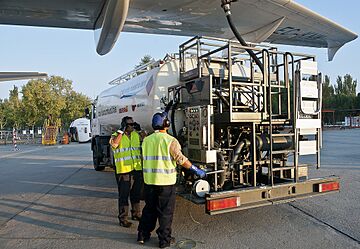Aviation biofuel facts for kids
An aviation biofuel (also known as sustainable aviation fuel or SAF) is a special type of fuel used to power aircraft. Regular jet fuel comes from oil, which is found deep underground. When we burn oil, it releases gases into the air. These gases add to climate change. That's why scientists are looking for cleaner ways to fly planes. Aviation biofuel is one of these cleaner options!
Contents
What is Aviation Biofuel?
Aviation biofuel is a type of fuel made from plants and other natural materials. It's different from fuel made from oil. Imagine using plants that grow above the ground instead of oil from deep below! This fuel can be used in the same airplane engines as regular jet fuel. Often, it's mixed with traditional fuel. This mix is what we call "sustainable aviation fuel" or SAF. The main idea is to use less oil-based fuel.
How is Aviation Biofuel Made?
Making aviation biofuel involves several steps. The process changes depending on what material is used. Here are some common examples:
From Tiny Algae
Tiny plants called algae can be grown in big tanks or ponds. Once they grow, they are collected. Then, oils are taken out of them. These oils are cleaned to make fuel for airplanes. Scientists have been studying this since the early 2000s. One acre of algae can make a lot of fuel. It can produce as much as several acres of other biofuel sources.
From Used Cooking Oil
Did you know that used cooking oil from restaurants can become airplane fuel? This is a great way to reuse something that might otherwise be thrown away. The oil is cleaned and processed. Then, it's changed into fuel that planes can use. Making fuel this way has grown a lot since the mid-2010s.
From Other Plants
Many other plants can also be used. These include plants like jatropha (a type of shrub), soybeans, and even waste from forestry. The process usually involves taking oils from these plants. Then, these oils are refined into biofuel. Scientists are still looking for the best and most eco-friendly plants for making biofuel.
Why Use Aviation Biofuel?
Aviation biofuel has several good points:
- Less Greenhouse Gas: Plants absorb carbon dioxide as they grow. So, even though making biofuel releases some gases, it still helps reduce overall greenhouse gases. This is better than burning only oil.
- Cleaner Air: Burning biofuel can also produce fewer harmful pollutants. This means cleaner air near airports and along flight paths.
- Renewable Resource: Unlike oil, which is limited, many materials for biofuel can be regrown. This makes it a more sustainable choice. This is important as more people travel by air.
- Energy Security: Using biofuel means we rely less on oil. This can help countries have more control over their own energy security.
What are the Challenges?
Even with its benefits, there are challenges to using aviation biofuel everywhere:
- Cost: Right now, making aviation biofuel is often more expensive than making regular jet fuel. Scientists are working to make the process cheaper.
- Land Use: Some ways of making biofuel need a lot of land. This could affect food production or natural habitats. Scientists are looking for ways to grow more fuel on less land. They are also exploring ideas like vertical farming.
- Sustainability: It's important that biofuel production is truly sustainable. It should not harm ecosystems. This means choosing the right materials and using eco-friendly processes.
- Scalability: The world's airlines need a huge amount of fuel. Making enough biofuel to meet this demand is a big challenge. It needs a lot of investment and new technology.
The Future of Aviation Biofuel
Despite these challenges, the future of aviation biofuel looks bright. Many airlines and governments are putting money into research. The technology is getting better quickly. The International Civil Aviation Organization (ICAO) wants the airline industry to greatly reduce its carbon footprint. Biofuels are a key part of this plan. Many major airlines have promised to use a lot more biofuel in the coming years.
Interesting Facts About Aviation Biofuel
- In 2008, a Boeing 747-400 plane flew successfully using a mix of regular jet fuel and biofuel. This biofuel came from algae and other sources. This showed that big planes could use it.
- Some biofuels can be made from things you might find in your kitchen, like used vegetable oil! This shows how waste can become something useful.
- Biofuels made from photosynthetic algae could save the most emissions (98%). However, this technology is still developing. Biofuels from non-food crops and forest waste can save 91–95% of emissions.
- Using biofuels for planes is expected to grow a lot soon. This shows a global effort to lower carbon emissions from transportation. Many experts believe biofuels will be a big part of airplane fuel in the next few decades.
See also
 In Spanish: Biocombustibles para la aviación para niños
In Spanish: Biocombustibles para la aviación para niños
- Biodiesel
- Fossil fuel phase-out
- List of emerging technologies
- Vegetable oil fuel


